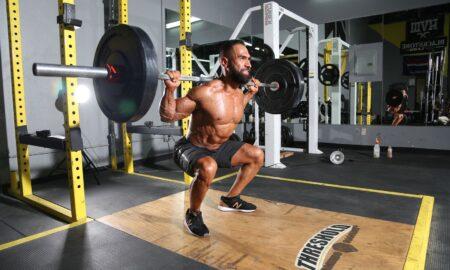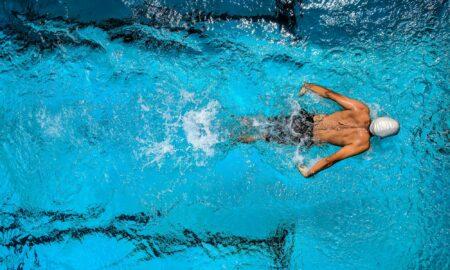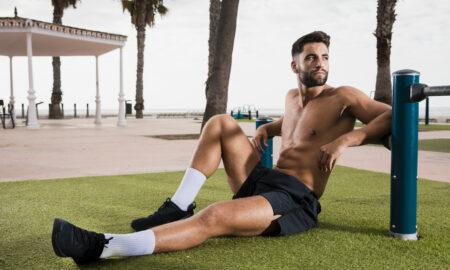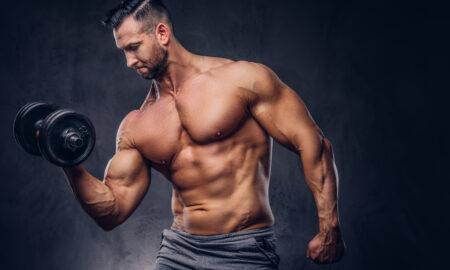Your nutrition program is absolutely vital to achieving peak condition and attaining a ripped physique. Unfortunately, the diet that worked for you once may no longer be applicable as you age. Like it or not, your metabolism slows down when you reach middle age. Fat accumulates much more easily, and the hard-earned muscle mass that you work so diligently to achieve finds little reason to stick around. More fat and less muscle do not equate to the ideal bodybuilding physique.
I experienced that changing-physique phenomenon over the past few years as I attempted to reach peak condition for the natural bodybuilding competitions I entered from 2001 to ’04, which I discussed in last month’s column. After trying and failing two years in a row’01 and ’02’I knew I needed to make adjustments to my precontest diet to achieve my goal.
Having won the Natural Mr. Universe contest twice (’92 and ’96), as well as taken first place in the Natural Olympia (’98) and achieved victory in many local and regional competitions, I thought I had the dieting thing down. Then, after tearing my biceps in 2000, I had a very difficult time getting back to the type of condition I once displayed. The fact is, my body started changing right around the time I turned 35, which was in 1998. My Natural Mr. Universe precontest diet contained a high percentage of complex carbohydrates, moderate protein and very little fat’approximately 60 percent carbs, 30 percent protein and 10 percent fat. To prepare for the Natural Olympia, I decided to make some slight changes. I kept my precontest calories the same’approximately 2,800 to 3,000’but I increased fats while slightly decreasing carbs. The breakdown of that diet was 38 percent protein, 47 percent carb and 16 percent fat.
Both of those diets worked great for me. I followed both for 12 to 16 weeks and was able to compete in ripped condition, and I won first place in both competitions.
When I came back to competition in 2001, after a three-year layoff, I decided to follow the same diet that had brought me such great results in ’98. I wasn’t buying into the low-carb craze that everyone seemed to be following because I knew what had worked for me in the past. I believed that a bodybuilder needed to eat a certain amount of carbohydrates to conserve muscle tissue. Carbs are said to be protein sparing, which means that the body uses them for energy. That leaves more protein for rebuilding muscle. During a low-carbohydrate diet the body may be forced to break down protein to use as an energy source after its carbs have become depleted.
I knew bodybuilders who successfully followed a low-carb diet for competitions, and they looked fantastic, but they were all using steroids. The drugs enabled them to maintain muscle tissue no matter how few carbs they consumed. I believed that as a natural bodybuilder I would surely sacrifice muscle tissue following a diet like that.
So what happened? When I competed in 2001 and 2002, my results were disappointing, to say the least. The fat came off much more slowly, and I failed to reach peak condition in time for the competitions despite the fact that I gave myself 20 weeks.
Injuries forced me to forgo competing in ’03, but I decided to make another attempt at reaching peak condition again in ’04. This time I purposely avoided bulking up in the off-season so I wouldn’t have as much fat to lose.
I began my precontest diet on May 1, a full 24 weeks before my first competition, which was scheduled for October 23. I weighed 230 pounds, and I planned on competing at approximately 205. If I lost only one pound a week, I would weigh 206 pounds for the contest.
Here’s how my menu looked when I began my precontest diet:
Meal 1: 1 egg, 9 egg whites, 1 cup oatmeal, half cup blueberries
Meal 2 (protein drink): 2 servings Pro-Fusion protein powder in water, 70 grams banana, 1 tablespoon flaxseed oil
Meal 3: 5 ounces extra-lean turkey, half cup brown rice, 3 tablespoons salsa, 1 cup turkey chili
Meal 4 (preworkout drink): 1 serving whey protein, 1 serving creatine
Meal 5 (postworkout drink): 3 scoops RecoverX in water
Meal 6 (protein drink): Muscle Meals meal replacement, 90 grams banana, half cup oat bran, half cup blueberries
Meal 7: 7 ounces round steak, 1 cup green beans
Totals: 3,133 calories, 323 grams protein, 313 grams carbohydrate, 63 grams fat
Breakdown: 41 percent protein, 40 percent carb, 19 percent fat ALL I was now eating a diet consisting of more protein and fat but slightly fewer carbohydrates. I kept my calories between 2,800 and 3,100 per day’more on workout days’for a weekly average of 2,950 calories. My carbohydrate consumption averaged approximately 300 grams per day. I ate a little more than 300 grams of carbs on my weight-training days and 250 grams on my days off.
Despite my strict adherence to the diet, my fat loss was very slow and frustrating. I measured my progress by the circumference of my waist along with my bodyweight, both of which I recorded first thing every morning. I knew my weight wasn’t as important as what I looked like, so I was more concerned with my waist measurement than I was my bodyweight.
I also knew from my previous wins at the Natural Universe and Natural Olympia that a waist measurement of 32 to 33 inches was ideal for my physique. At 230 pounds I had a bulky 37-inch waist, which meant that I’d need to lose a minimum of four inches before I was ready to step onstage. I decided to give myself a little more time than the minimum of 16 weeks, just in case I needed it.
On August 14, 2004, after 15 weeks of dieting, my bodyweight was down to 215 pounds, and my waist was at 35 inches. I’d lost 15 pounds and two inches off my waist. I only had nine weeks left, and I still needed to lose a minimum of two more inches off my waist. My weekly average of calories per day was now at 2,800, and my carbohydrate average had dropped to 270 grams per day.
When I was only six weeks away from my first contest, I decided to make some changes to my diet. I went to my friend and fellow competitor Joe Silzer. Joe competes on the national level and is obviously aware of what the judges look for.
At that point my bodyweight was down to 213.5 pounds with a 34-inch waist. My progress had been very slow, and my waist had not lost any fat for the past three weeks. I had Joe take some pictures of me that day, and we both had the same view. I needed to get much harder’and quick!’or I would not be ready in time.
My first solution was to increase my cardio. I’d been doing cardio three to four days a week, so I decided to increase it to a minimum of six days per week to accelerate the fat loss. After four days of nonstop cardio, my waist stubbornly remained at 34 inches, and my bodyweight also refused to budge.
I called Joe up, and we went over my diet, meal by meal. Joe advised me to drop my carbohydrate intake even lower in order to get harder. Here are the changes we decided to make:
Meal 1: same
Meal 2: eliminate the banana
Meal 3: change to 6-ounce chicken breast, 120 grams sweet potato, 3 ounces broccoli or asparagus Instead of extra-lean turkey, I began eating chicken breast, which is a little bit higher in fat and calories. I dropped the half cup of brown rice and replaced it with a small sweet potato, which has a lower glycemic-index number than the brown rice. I also eliminated the turkey chili, which was high in fiber and contained no sugar but was too high in carbs. I substituted very low-calorie broccoli or asparagus, which was also high in fiber but contained a fraction of the carbohydrate.
Meal 4: same
Meal 5: same
Meal 6 (protein drink): 2 servings Pro-Fusion, 1 tablespoon natural peanut butter I also drastically changed this meal, which I had about 30 minutes following my RecoverX drink. Instead of the Muscle Meals shake with a banana, I used two scoops of Pro-Fusion and no banana. That contains half the carbs of a packet of Muscle Meals (only six grams of carbs compared to 12 in the Muscle Meals), and cutting out the banana reduced my total carbohydrate intake even further. I also eliminated the oat bran and blueberries, using a tablespoon of natural peanut butter instead.
Meal 7: same
Meal 8 (protein drink): 2 scoops of Pro-Fusion with 1 tablespoon flaxseed oil. The flaxseed oil supplied more essential fatty acids and helped slow down the digestion of the protein drink. Since I wouldn’t be eating anything until the next morning, it was important to keep the muscle cells saturated with the growth-producing amino acids from the protein drink. Taking in a fast-acting form of protein such as whey before retiring would have been a mistake.
The diet provided me with approximately 2,800 calories, 340 to 350 grams of protein, 200 grams of carb and 65 to 70 grams of fat. Although the calories were the same as the diet that I’d been following for the previous 18 weeks, the macronutrient percentages were different. My carbohydrate intake dropped by 100 grams per day. Instead of getting 250 to 300 grams of carbs, I dropped to 150 to 200. To keep the calories the same, I slightly increased my protein from 320 to 350 grams per day, and I also increased my fat from approximately 55 grams per day to 70.
It was necessary to get more fat because of the carb decrease. I knew I’d risk losing muscle size and fullness if I reduced the carbs but kept the fat the same. The added flaxseed oil and the tablespoon or two of natural peanut butter a day helped me maintain my muscle mass while I was eliminating bodyfat.
So how did my experiment work? Like a charm! I started losing fat almost immediately. I changed my diet on a Wednesday; by that Saturday my waist had dropped half an inch, and my bodyweight was down by two pounds. Even better, my progress from that point was consistent. I lost 1.5 to two pounds each week, and my waist got smaller.
By the time my competition arrived, I was in the best shape I’d been since taking the Natural Olympia in ’98. Six years is a long time between winnings, but that was how long I had to wait. On October 23, 2004, my drought finally ended as I took the overall at the Natural America’s Cup competition. My bodyweight was at 205 pounds, and my waist was down to 33 inches, very close to peak condition.
Four weeks later, on November 21, 2004, I’d reduced my bodyfat even more. I competed in the Natural Mr. Universe weighing 200 pounds. It was the best I’d looked in more than five years, and it was a far cry from the lackluster physique I’d displayed in the previous few years.
What was amazing about this new, improved version of my diet was that I was able to retain all of my muscle mass while losing the fat. My beliefs regarding the importance of carbohydrates in a precontest diet drastically changed. I now believe that it’s possible to eat fewer carbs and maintain your muscle mass and strength, even if you’re a natural bodybuilder.
The key to my diet was finding the right number of calories I needed to lose weight and keeping that calorie intake the same while changing the percentages of the macronutrients. When I decided to reduce my carbohydrates by 100 grams per day, I simultaneously had to increase my protein and fats so my calories didn’t drop. If they had by a significant amount, I no doubt would have sacrificed muscle tissue due to the heavy weight-training workouts and the four to five sessions of cardio per week. When you’re a natural bodybuilder, your energy has to come from somewhere. Eating fewer carbs necessitates getting more fats and protein just as a higher carb intake demands a much lower fat intake.
If you’re attempting to get lean and feel that it’s no longer possible because you’re not as young as you were, don’t give up and head for the couch. You may just need to change the percentages of protein, carbs and fats that you’re getting in order to get results. Record your diet in a journal each day, and keep experimenting until your body responds. Once you find the right diet, a ripped physique may be right around the corner.
Editor’s note: John Hansen has won the Natural Mr. Olympia and is a two-time Natural Mr. Universe winner. Visit his Web site at www .naturalolympia.com. You can write to him at P.O. Box 3003, Darien, IL 60561, or call toll-free (800) 900-UNIV (8648). His new book, Natural Bodybuilding, is now available from Human Kinetics Publishing. IM




















You must be logged in to post a comment Login